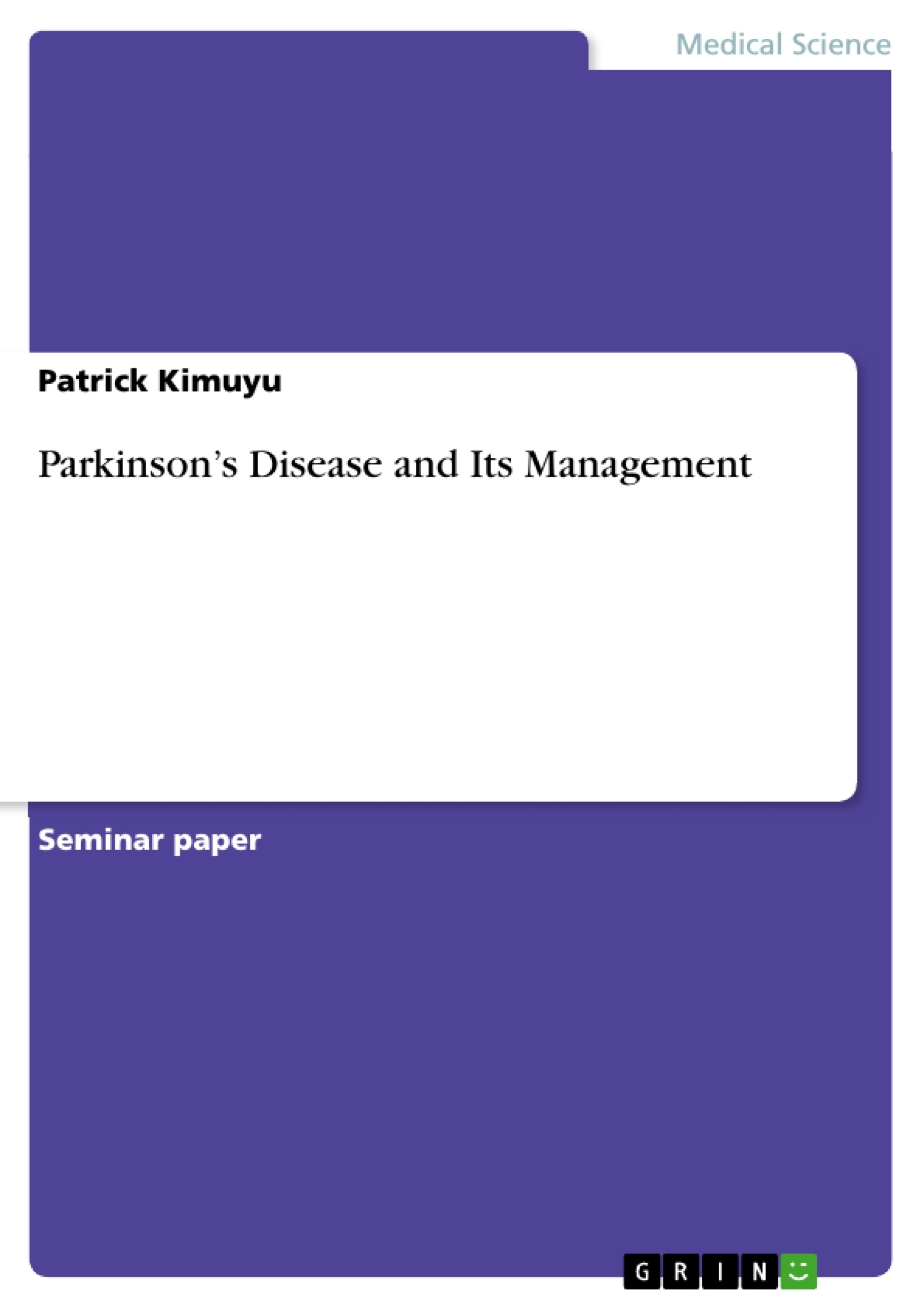This report provides an overview of Parkinson’s disease and its management.
Parkinson’s disease (PD) is considered as a progressive disorder of the central nervous system, and it is characterized by difficulties in movement. This disorder is also referred to as the shaking palsy owing to the tremors experienced by the patients. It is one of the most challenging motor system disorders because it is both chronic and progressive; implying that symptoms emerge and worsen over time. Therefore, the management of Parkinson’s disease presents an immense challenge to healthcare professionals, as well as families and relatives of patients suffering from the disease. Currently, there is no cure for Parkinson’s disease; thus, treatment approaches focus on reducing the severity of its symptoms.
Table of Contents
Introduction
Epidemiology
Pathophysiology
Signs and Symptoms
Diagnosis
Treatment
Conclusion
References
Introduction
Parkinson’s disease (PD) is considered as a progressive disorder of the central nervous system, and it is characterized by difficulties in movement. This disorder is also referred to as the shaking palsy owing to the tremors experienced by the patients (Lyons & Pahwa 2007). It is one of the most challenging motor system disorders because it is both chronic and progressive; implying that symptoms emerge and worsen over time. Therefore, the management of Parkinson’s disease presents an immense challenge to healthcare professionals, as well as families and relatives of patients suffering from the disease. Currently, there is no cure for Parkinson’s disease; thus, treatment approaches focus on reducing the severity of its symptoms.
Aetiology of Parkinson’s disease remains uncertain (Lippincott Williams & Wilkins 2005). However, environmental and genetic factors have been hypothesized as the principal cause of the disease condition. It is believed that a combination of environmental and genetic factors account for the onset of Parkinson’s disease in most people. Some of the most significant environmental risk factors associated with Parkinson’s disease include exposure to pesticides and herbicides, proximity to industries, and consumption of well water (Wirdefeldt, Adami, Cole, Trichopoulos & Mandel 2011). On the other hand, evidence indicates that genetic factors account for 10% of Parkinson’s disease cases (Hauser 2014). Berkris, Mata and Zabetian (2010, p. 228) report “Mutations in 6 genes (SNCA, LRRK2, PRKN, DJ1, PINK1, and ATP13A2) have conclusively been shown to cause familial parkinsonism; common variation in 3 genes (MAPT, LRRK2, and SNCA) and loss-of-function mutations in GBA have been well-validated as susceptibility factors for PD.” This report provides an overview of Parkinson’s disease and its management.
Epidemiology
Epidemiological studies indicate that Parkinson’s disease affects about 1% of people order than 60 years. It is estimated that the prevalence of Parkinson’s disease is 120 cases per 100,000 people, and its incidence rate ranges from 4.5 to 21 cases in the same population. However, the prevalence of the disease exhibits demographic trends. For instance, its prevalence rate in men is 1.5 times more than in women. On the other hand, this disease exhibits racial and ethnic trends in which the Europeans and Americans are more affected than Asian communities (Tan & Louis 2013). Hispanics are known to have the highest prevalence rate of the disease (Muangpaisan, Hori & Brayne 2009). Currently, one million Americans, 9,000 Chinese and 127,000 people in UK are suffering from Parkinson’s disease.
Abbildung in dieser Leseprobe nicht enthalten
Pathophysiology
From a pathological perspective, it is relatively difficult to explain the pathophysiology of Parkinson’s disease because its neuropathologic trends have not been understood. However, there are some parameters that suggest the progression of the disease condition. Some of these parameters include the presence of Lewy neurites and Lewy bodies, as well as, the absence of some dopaminergic neurons in the brain. Evidence indicates that the pigmented dopaminergic neurons which are predominantly found in the substantia nigra of the ventral lateral region of the brain disappear before the onset of Parkinson’s disease symptoms. This situation has been identified to occur in 60% to 80% of Parkinson’s disease cases (Hauser 2014).
On the other hand, Lewy bodies have been found to play a pathological role in the progression of Parkinson’s disease. This is so because the prevalence of incidental Lewy bodies and neurites increase with age. As such, they are believed to have pathological influence during the pre-symptomatic phase of the disease.
[...]
- Citation du texte
- Patrick Kimuyu (Auteur), 2018, Parkinson’s Disease and Its Management, Munich, GRIN Verlag, https://www.grin.com/document/388411
-

-

-

-
Téléchargez vos propres textes! Gagnez de l'argent et un iPhone X. -

-
Téléchargez vos propres textes! Gagnez de l'argent et un iPhone X. -

-
Téléchargez vos propres textes! Gagnez de l'argent et un iPhone X. -

-
Téléchargez vos propres textes! Gagnez de l'argent et un iPhone X. -

-
Téléchargez vos propres textes! Gagnez de l'argent et un iPhone X.

